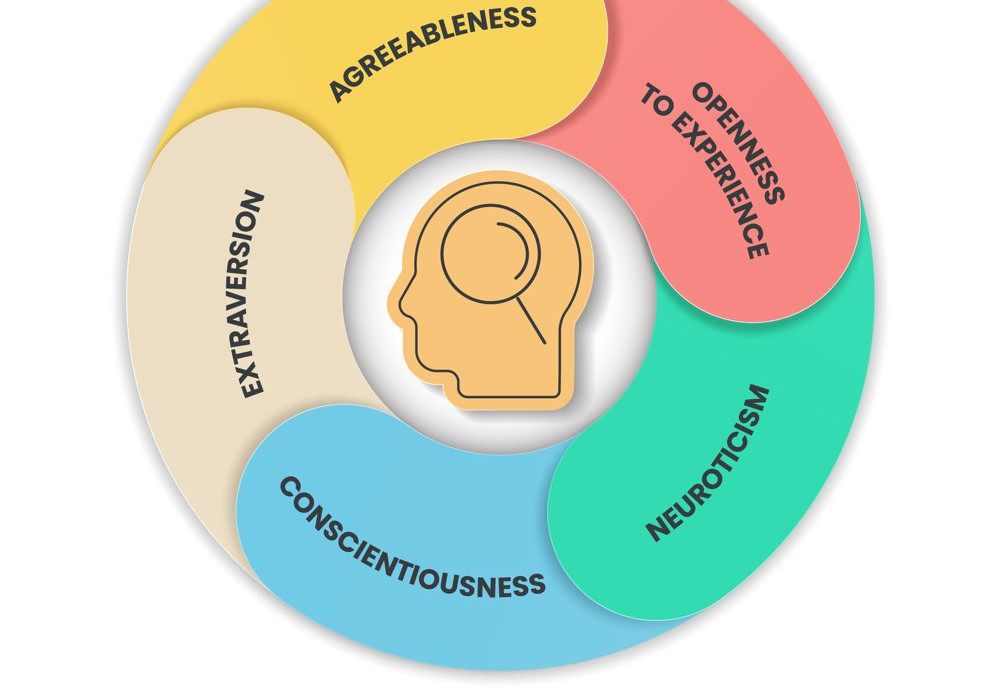Human personality, you know that unique, dynamic blend of thoughts, feelings, and behaviours that define us, has been a subject of fascination for centuries. From ancient Greek theories of humours and temperaments to contemporary scientific research, the quest to understand why we behave the way we do has remained a constant pursuit. One of the most impactful contributions to this field is the concept of personality traits, especially as they are defined by the Big Five model.
Understanding our personality traits can provide a wealth of insight into how we relate to the world and those around us. It offers a blueprint of our behaviours, motivations, and preferences, helping us make sense of why we feel and act the way we do in different circumstances. It can even guide our life choices, from career paths and relationships to hobbies and lifestyle habits.
Perhaps the most comprehensive and widely recognised tool we have for deciphering this intricate puzzle is the Big Five Personality Traits model. This model, backed by decades of psychological research, breaks down human personality into five broad, defining characteristics and uses the acronym ‘OCEAN’
Openness to experience
Conscientiousness
Extraversion
Agreeableness
Neuroticism
These traits are often remembered by the acronym OCEAN. In this post, we will expore and help you understand the origins, characteristics, and implications of the Big Five Personality Traits model, look at how these traits influence our lives, how they are measured, and how they are currently viewed within the realm of psychological research. We’ll also touch upon some of the criticisms and limitations of this model, providing a balanced perspective. So, let's dive in, and perhaps, along the way, gain a deeper understanding of ourselves.
In the beginning
The Big Five Personality Traits model is an empirical concept born out of complex psychological research. With origins dating back to the mid-20th century, the model has evolved from numerous independent studies focused on identifying common threads within human personalities. The late 1950s marked the inception of this idea when Ernest Tupes and Raymond Christal proposed five broad factors of personality. Despite their groundbreaking work, it was pretty much overlooked until the 1980s when the psychological community revisited and expanded on these fundamental concepts.
Among the key researchers who gave new life to the Big Five model were Robert R. McCrae and Paul Costa. They utilised a statistical method known as factor analysis to identify patterns within personality survey data, leading them to the same five distinct traits proposed earlier. These traits, encompassing the full range of human personalities, formed the foundation of the Big Five model.
Fast forward to the present, the Big Five model, also known as the Five Factor Model, is widely accepted in modern psychology, with its five core traits universally recognised as the primary dimensions of human personality.
A quick overview
The model focuses on five defining characteristics that provide a comprehensive understanding of human personality. Each trait exists on a continuum, representing the wide range of human behaviours and attitudes.
Openness to Experience: Describes individuals who are curious, imaginative, and receptive to new experiences. People with high openness appreciate arts, adventure, and novel ideas. At the other end of the continuum, individuals low on openness tend to lean towards traditional beliefs and routines.
Conscientiousness: is characterised by organisation, responsibility, and a methodical approach to life. They have a strong sense of duty and are typically meticulous and goal-oriented. Individuals with low conscientiousness may prefer spontaneity over structure and planning.
Extraversion: Refers to people who are outgoing, assertive, and energetic. Extraverts thrive on social interaction and tend to seek out company. Conversely, introverts are more reserved and prefer smaller social interactions or solitude and to think before they speak.
Agreeableness: Agreeable individuals are known for their empathy, kindness, cooperation, and consideration for others. They are willing to compromise for harmony. Those with lower agreeableness scores may be more competitive and less likely to back down from conflicts.
Neuroticism: Is characterised by emotional instability and a propensity for negative emotions. High neuroticism can lead to feelings of anxiety, sadness, or anger. On the flip side, individuals with low neuroticism are usually more emotionally stable and less prone to emotional distress or outbursts.
Remember, these traits exist on a spectrum, with every individual expressing a unique blend of these five traits, which shape our thoughts, behaviours, and how we interact with the world around us, which we'll further explore in the upcoming sections.
The Influence of the Big Five on our everyday lives
Understanding these traits can offer an incredibly helpful insight into ‘us,’ our behaviours, choices, relationships, and overall life outcomes. Here, we will explore how each of these traits can impact various aspects of our lives.
Openness to Experience high scorers tend to be more adaptable to change and thrive in innovative and creative environments. They often enjoy diverse experiences, leading them to explore various interests and perspectives. However, high openness may sometimes result in a lack of focus or practicality.
Conscientious individuals are typically organised, punctual, and dependable. These traits contribute to success in academia and work, particularly in fields that require meticulous detail and discipline. However, they might also struggle with rigidity or have difficulty adapting to sudden changes.
Extraverts usually excel in social situations and thrive in professions that require interaction, such as sales, teaching, or leadership roles. They may have a broad social network and enjoy engaging in various activities. However, they might find it challenging to spend time alone or work independently for long periods.
Highly agreeable individuals often excel in teamwork and tend to have harmonious relationships. They are usually well-liked and may be suited for roles that require empathy and cooperation. However, their desire to maintain harmony might make it difficult for them to engage in conflict, assert their own needs or take tough decisions.
High levels of neuroticism may be associated with a higher likelihood of experiencing stress, anxiety, and mood changes. These individuals may find it challenging to cope with high-pressure situations or demanding roles. However, their emotional sensitivity could also make them highly empathetic and creative.
Recognising the influence of these traits can help us make better-informed decisions, improve our interactions, and play to our strengths.
Measuring the Big Five
Quantifying personality traits might seem challenging, but several scientific tools and methods have been developed to measure the Big Five traits accurately.
The most common measure is the NEO Personality Inventory (NEO PI-R), a 240-item questionnaire developed by McCrae and Costa, which provides a detailed profile of an individual's personality across the five traits. A shorter, but still reliable alternative is the Big Five Inventory (BFI), which consists of 44 items.
These self-report measures are widely considered reliable, meaning they provide consistent results over time, reflecting the stability of personality traits. They are also considered valid, as they measure what they claim to - the five broad domains of personality.
However, the accuracy of these measures depends on honest self-reporting. Individuals might sometimes portray themselves in a way they perceive as socially desirable rather than being entirely truthful.
Once individuals receive their scores, they can compare them with normative data. Understanding these scores can reveal significant insights about our personalities, enabling self-growth and enhanced interpersonal understanding. However, it's crucial to interpret these scores as descriptive rather than prescriptive, ie they don't confine or define us, but rather, offer insights into our personality structure.
Criticisms and potential limitations of the Big Five Model
While the Big Five model is a valuable tool for understanding personality, it is not without its critics. It's important to consider these criticisms and limitations to maintain a balanced perspective of the model.
Oversimplification: Some argue that the Big Five model oversimplifies the complexity of human personality by reducing it to only five dimensions. Some aspects of personality, such as humour or spirituality, don't fit neatly into the five categories, leading critics to suggest that the model may not capture in full the richness of a human personality.
Cultural Bias: Critics also point out the potential for cultural bias, as the Big Five model was developed primarily through research on Western populations. Different cultures may emphasise different values or behaviours, and these nuances might not be fully captured by the Big Five traits.
Self-report Bias: As the Big Five traits are often measured through self-report questionnaires, responses can be influenced by a person's self-perception or desire to present themselves in a particular way. This can potentially compromise the accuracy of the results.
Lack of Explanation: Another common criticism is that the Big Five model describes personality rather than explaining it. While it effectively categorises different traits, it doesn't drill into the underlying psychological processes that drive these traits.
Implications for future research and practice
Despite these potential limitations, the Big Five model continues to be a cornerstone in personality research and has paved the way for numerous studies on personality and behaviour.
Future Research: Current trends in personality research involve refining and expanding upon the Big Five model. Some researchers are exploring the possibility of a sixth trait, often referred to as Honesty-Humility. Others are focusing on the lower levels of the personality hierarchy, examining the facets and nuances within each of the five broad traits.
Practice Implications: The Big Five model continues to have wide-ranging applications in a wide variety of fields. For instance, in clinical psychology, it can help in diagnosing and treating mental disorders, in the workplace, it can be used in recruitment and team-building activities. As such, the ongoing research and refinement of the model promise to enhance these applications further.
The Big Five model, with its strengths and limitations, serves as a valuable tool for understanding human personality. As we continue to research and refine our understanding of personality traits, we can look forward to even more precise and comprehensive ways of understanding who we are - and why.
Conclusion
The Big Five Personality Traits model offers a comprehensive lens through which we can understand human personality. This model, developed through decades of empirical research, reduces the complex spectrum of human personality to five core traits: Openness to Experience, Conscientiousness, Extraversion, Agreeableness, and Neuroticism.
Understanding these traits can help us gain insights into our behaviours, choices, and relationships. Although the model is not without its limitations, as outlined above, it remains a pivotal tool in personality psychology. Current research trends suggest that the model will continue to evolve, bringing us even closer to unravelling the intricacies of human personality.
So, now it might be helpful for you to reflect on these traits and how they may manifest in your life. Remember, there are no "rights" or "wrongs" when it comes to personality traits, each of us is a unique blend of these traits, contributing to the rich tapestry of human diversity.
Further Reading
For those interested in delving deeper into the Big Five Personality Traits model and its implications, here are a few recommended books and articles:
"Personality: What Makes You the Way You Are" by Daniel Nettle. This book offers an engaging and accessible introduction to personality psychology, with a particular focus on the Big Five model.
"The Big Five Personality Traits and the Life Course: A 45-Year Longitudinal Study" by Paul T. Costa Jr., and Robert R. McCrae. This seminal research paper offers a comprehensive look at how the Big Five traits influence life outcomes over a span of 45 years.
"Measuring the Big Five Personality Domains" by Samuel D. Gosling, Peter J. Rentfrow, and William B. Swann Jr. This academic paper provides a detailed explanation of the different methods used to measure the Big Five traits.
Free Big 5 assessment: https://truity.com/test/big-five-personality-test
These resources provide further insights and perspectives on the Big Five model, making them an excellent starting point for anyone looking to broaden their understanding of this influential psychological framework.

